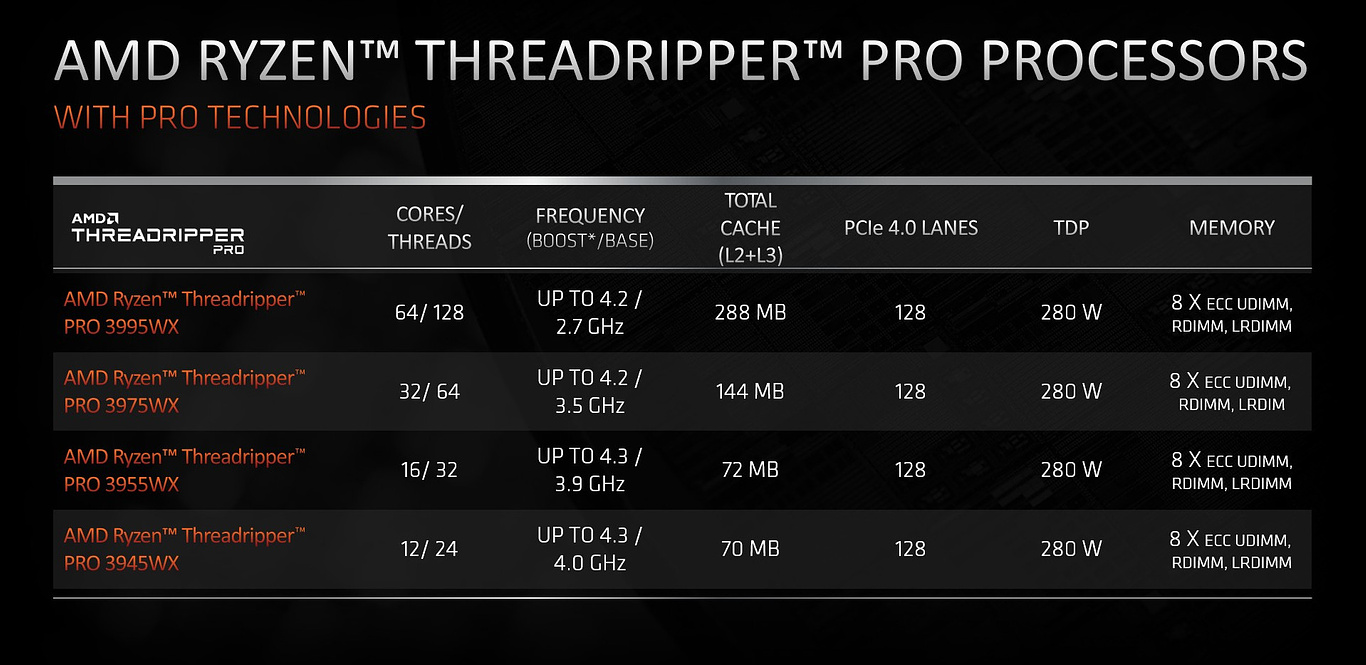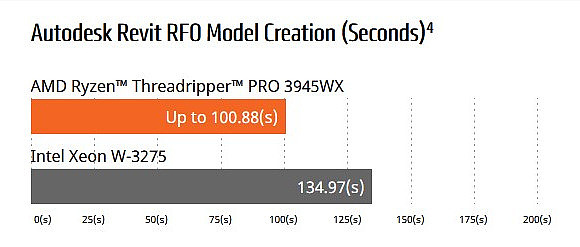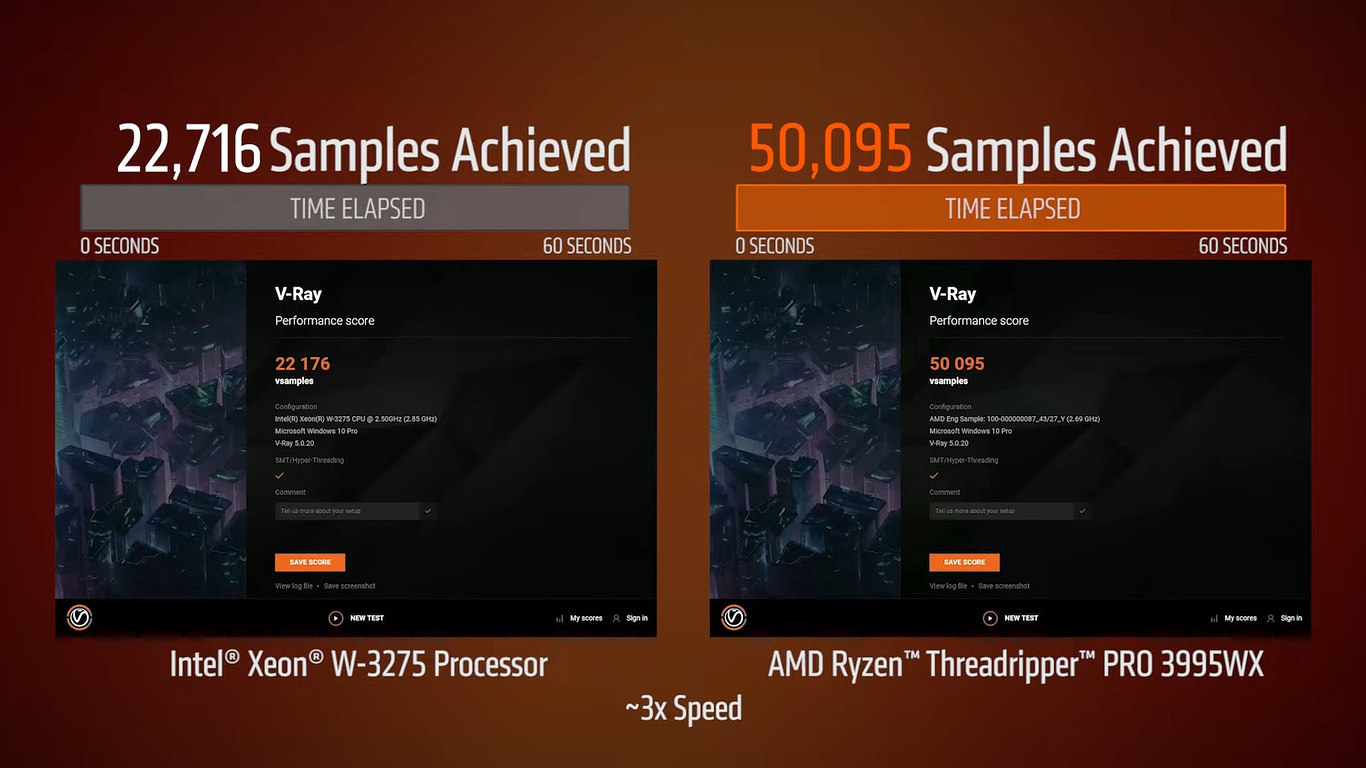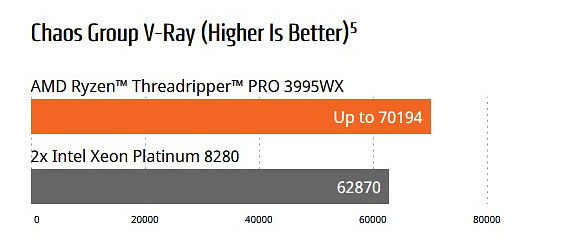
Other
Why AMD Ryzen™ Threadripper™ PRO Processors continue to rewrite the rules of visualization
Advertisement brought to you by AMD
When choosing CPUs for their workstations, architectural professionals traditionally faced an insoluble dilemma. Lightly threaded applications like CAD and BIM tools benefit from high CPU clock speeds; heavily threaded applications like renderers and reality capture software benefit from large numbers of CPU cores. But you couldn’t have both. As core count rose, CPU clock speed fell dramatically. Worse still, each core provided incrementally less extra performance, even with highly threaded applications – while to reach very high core counts, two CPUs were required, greatly increasing the cost and power consumption of the machine.
Thanks to AMD Ryzen™ Threadripper™ PRO Processors, those days are over. The four chips – the AMD Ryzen™ Threadripper™ PRO 3995WX, AMD Ryzen™ Threadripper™ PRO 3975WX, AMD Ryzen™ Threadripper™ PRO 3955WX and AMD Ryzen™ Threadripper™ PRO 3945WX – provide an unprecedented combination of high clock speeds and high core counts. The entry-level AMD Ryzen Threadripper PRO 3945WX is the first twelve-core workstation CPU with a boost clock speed up to 4.3GHz [1,2], while the AMD Ryzen Threadripper PRO 3995WX is the first workstation processor to offer 64 cores in a single CPU socket.
Additionally, AMD Ryzen Threadripper PRO Processors support PCIe® 4.0, which enables artists and architects to benefit from the full power of the other components in their machines: from multiple GPU set-ups for hardware-accelerated ray tracing to blazing-fast data retrieval from modern NVMe solid state drives. AMD Ryzen Threadripper PRO Processors enable artists and architects to benefit from the full power of the other components in their machines: from multiple GPU set-ups for hardware-accelerated ray tracing to blazing-fast data retrieval from modern NVMe solid state drives.
First available in the Lenovo ThinkStation P620 graphics workstation, Threadripper PRO Processors can now be bought directly from retail outlets or through leading workstation system integrators throughout North America, Europe and the Asia-Pacific regions, giving architectural professionals complete control over how they configure their machines.
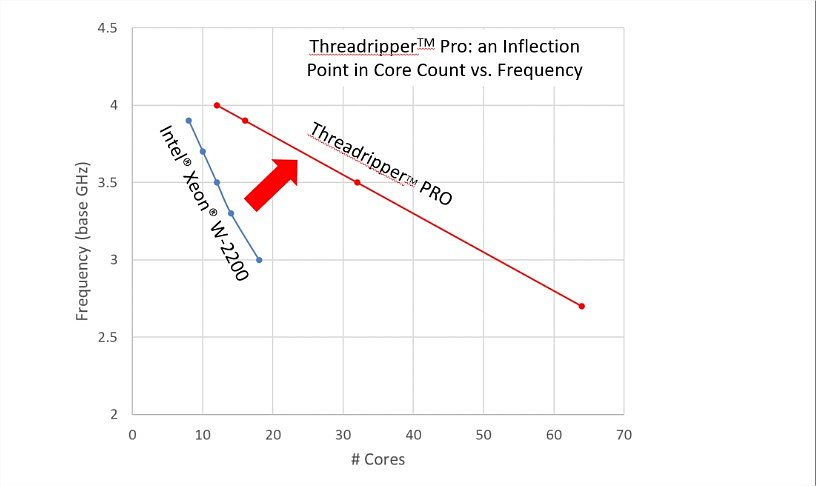
Threadripper PRO Processors: a breakthrough in CPU design
Since 2017, AMD Ryzen Threadripper Processors have been disrupting the industry with a combination of high core counts and affordable prices, winning converts among architecture and design professionals. But with the Threadripper PRO Processors, AMD has made its most significant set of technical advances since launching the product family.
First, as the first workstation-class CPUs built on a 7nm manufacturing process, the “Zen 2” based chips provide double the transistor density [3] of previous AMD architecture. Second, rather than forcing more and more cores onto the same CPU die, the Threadripper PRO Processors break them into multi-core ‘chiplets’, tied to one another and to system memory via AMD Infinity Fabric™ technology.
As a result, CPU clock speed now diminishes much more slowly as CPU core count rises. Put simply, AMD Ryzen Threadripper PRO Processors offer more cores at higher base frequencies – and they do so within a single physical processor.
Single CPUs that can power multiple virtual machines
One studio to take advantage of the high core counts of AMD processors is VoxlVision. The Baltimore-based firm sets up multiple virtual machines on individual physical workstations, enabling several of its artists to share a single AMD processor when logging in remotely.
VoxlVision previously used Intel® processors for its work, which includes both architectural and product visualization, but switched to AMD when the original Threadripper processors were released. Vox|Vision now plans to adopt the AMD Ryzen Threadripper PRO 3995WX in production.
“For a studio like ours, scalability is key,” says VoxlVision founder Ted Vitale. “The beauty of high core counts is that I don't need to buy lots and lots of computers. A single Threadripper PRO Processor can eliminate the need for five or six [physical machines].”
Partitioning one machine into multiple virtual workstations not only enables VoxlVision to make better use of its limited office space but also saves the studio money on electricity and software licenses. The firm uses a range of single- and multi-threaded applications, including 3ds Max and SketchUp for modeling and scene assembly, and Enscape, Lumion, Unreal Engine and V-Ray for rendering.
“The high core count [of AMD processors] is key but having speed at that high core count is important too,” says Vitale. “Single-threaded applications are just painful unless you have a fast CPU.”
High CPU clock speeds accelerate CAD and BIM software
For modeling and design workflows, whether you’re working in 2D or 3D, the main benefit of the Threadripper PRO Processors will be the high clock speeds, since many widely used CAD and BIM applications are single-threaded, or use only a small number of CPU cores for key tasks.
In tests conducted by AMD using the standard RFO Benchmark, which measures the time taken by a workstation to open and edit a model in Autodesk Revit, the entry-level AMD Ryzen Threadripper PRO 3945WX was up to 25% faster than the Intel® Xeon® W-3275 workstation processor. [4]
And the fact that those high clock speeds are available across 12 or more CPU cores means that users can have other essential software like browsers, email clients and videoconferencing services open at the same time as their design applications, without performance suffering – particularly important in a world where many people are still working from home.
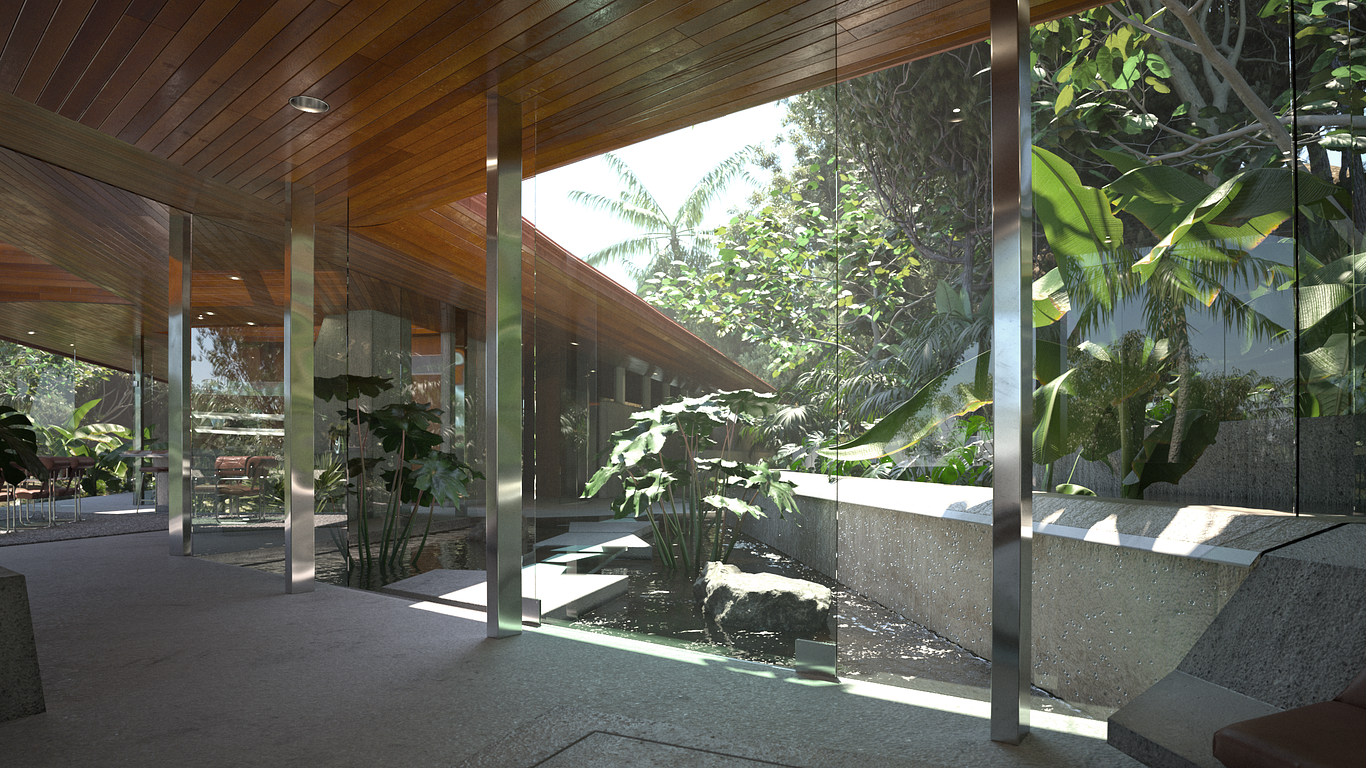
High core CPU counts power rendering and VR workflows
For heavily threaded applications, the high core counts are what makes the Threadripper PRO Processors – particularly the 64-core AMD Ryzen Threadripper PRO 3995WX – really shine.
That includes a range of key architectural tools, including photogrammetry and reality capture software, plus game engines like Unreal Engine, where extra CPU cores accelerate tasks like scene building and light baking, and renderers like Chaos Group V-Ray.
“The rendering power of the AMD Ryzen Threadripper PRO 3995WX is the best I've ever seen,” says Chris Nichols, Director of Chaos Group Labs, who tested the CPU using Chaos Group's own V-Ray benchmark and on scenes provided by leading architectural artists like Bertrand Benoit.
In the V-Ray 5 benchmark, the Intel® Xeon® W-3275 rendered 22,716 samples in a minute. The 64-core AMD Ryzen Threadripper PRO 3995WX rendered 50,095 samples in the same time: over 2.2x better rendering performance.
Nichols was also able to test the AMD Ryzen Threadripper PRO 3995WX against a more expensive workstation GPU, the NVIDIA Quadro RTX 8000, using the benchmark's V-Ray GPU test. “Because V-Ray GPU can use a CPU as an extra device, I was able to test the Threadripper PRO as a GPU device,” he said. “It ran faster than the RTX 8000 by up to 10%.”
A single Threadripper PRO Processor can even outperform much more expensive dual-socket systems. In tests conducted by AMD, a single AMD Ryzen Threadripper PRO 3995WX recorded a higher V-Ray benchmark score than dual Intel® Xeon® Platinum 8280 CPUs with a suggested price of over $20,000. [5,6]

Powerful connectivity, data security and system management features
For VoxlVision's Ted Vitale, another selling point for the new Threadripper PRO Processors is their support for PCI Express® 4.0, which provides twice the peak data transfer rate of the previous PCIe® 3.0 standard. The Threadripper PRO Processors provide 128 PCIe® 4.0 lanes, meaning that multiple GPUs or storage drives can run with full electrical connectivity, ensuring each performs to its full potential.
“Another reason Threadripper [CPUs] are so great is that we can have multiple GPUs in our systems and switch [GPU rendering] on and off when we need,” says Vitale. “Starting up software is also so much faster with PCIe® 4.0 and NVMe drives. Productivity has increased substantially.”
And while VoxlVision is a boutique studio, large architectural practices can also benefit from the security features and remote management that Threadripper PRO Processors offer. When working on commercially sensitive construction projects, AMD Memory Guard provides real-time encryption of system memory, helping to protect data if a machine is lost or stolen, while the AMD PRO manageability feature set enables IT staff to monitor, update and repair systems remotely, making it possible to support artists located in other offices around the world, or who are working from home.
Design and visualize without compromise
Now available to buy directly from retail outlets as well as via leading workstation manufacturers worldwide, AMD Ryzen Threadripper PRO Processors provide architects and visualization artists with the power they need to tackle the most demanding of design projects, all in one single-socket workstation.
With full-spectrum compute capabilities boosting performance in both lightly threaded and multithreaded tasks, high-speed connectivity with next-generation GPUs and SSDs via PCIe® 4.0, and professional security features and system management, these processors make the power of multi-core computing available to individual artists and studios of all sizes.
“AMD has done such a great job of making [highly multi-core CPUs] reliable and affordable,” says VoxlVision's Ted Vitale. “Having a fast, high-core-count CPU at a reasonable price gives you everything you need as a user.”
For more information on AMD Ryzen™ Threadripper™ PRO Processors for architectural visualization, please visit https://www.amd.com/en/processors/workstation-architecture-solutions
Note: Intel launched its Xeon W-3300 Series processors on July 29th 2021. AMD is in the process of procuring these new processors as they become available to evaluate their performance.
[1] Based on AMD internal analysis June 1, 2020, comparing specifications of AMD Ryzen Threadripper PRO to Intel® Xeon® Gold 6256 and Intel® Xeon® W-2265. CPP-01.
[2] Max boost for AMD processors is the maximum frequency achievable by a single core on the processor running a bursty single-threaded workload. Max boost will vary based on several factors, including, but not limited to: thermal paste; system cooling; motherboard design and BIOS; the latest AMD chipset driver; and the latest OS updates. GD-150.
[3] Based on June 8, 2018 AMD internal testing of same-architecture product ported from 14 to 7 nm technology with similar implementation flow/methodology, using performance from SGEMM. EPYC-07.
[4] Based on AMD performance lab testing on June 8, 2020 using the Autodesk Revit RFO v3.2 2020 test to compare the performance of AMD Ryzen Threadripper PRO 3945WX vs. Intel® Xeon® W-3275 processor. Results may vary. CPP-70.
[5] Based on AMD performance lab testing on June 8, 2020 using the V-Ray Benchmark 4.10.07 test to compare the multi-thread performance of AMD Ryzen Threadripper PRO 3995WX vs. 2X Intel® Xeon® Platinum 8280 processors. Results may vary. CPP-32
[6] Price based on data retrieved on June 12, 2021 from https://ark.intel.com/content/www/us/en/ark/products/192478/intel-xeon-platinum-8280-processor-38-5m-cache-2-70-ghz.html
DISCLAIMER
“Zen 2” is a code name for AMD architecture and is not a product name. The information contained herein is for informational purposes only and is subject to change without notice. While every precaution has been taken in the preparation of this document, it may contain technical inaccuracies, omissions and typographical errors, and AMD is under no obligation to update or otherwise correct this information. In addition, AMD PRODUCTS may include errata which cause the processor to deviate from published specifications and AMD will occasionally identify such product errata without notice but is under no obligation to do so. Advanced Micro Devices, Inc. makes no representations or warranties with respect to the accuracy or completeness of the contents of this document, and assumes no liability of any kind, including the implied warranties of noninfringement, merchantability or fitness for particular purposes, with respect to the operation or use of AMD hardware, software or other products described herein. No license, including implied or arising by estoppel, to any intellectual property rights is granted by this document. Terms and limitations applicable to the purchase or use of AMD’s products are as set forth in a signed agreement between the parties or in AMD's Standard Terms and Conditions of Sale. GD-140.
You must be logged in to post a comment. Login here.
About this article
Now available individually at online retailers and through leading workstation system integrators, AMD’s latest processors end the need to compromise between CPU core counts and high clock speeds
visibility2.96 k
favorite_border0
mode_comment0


